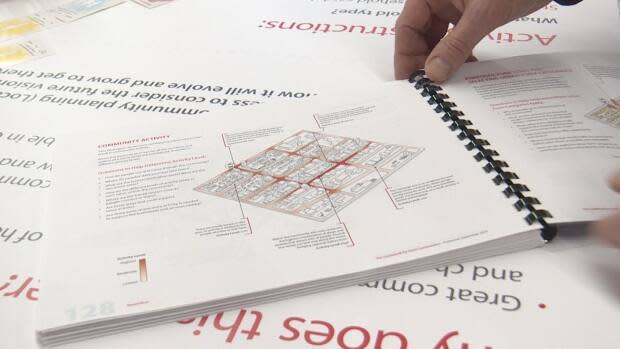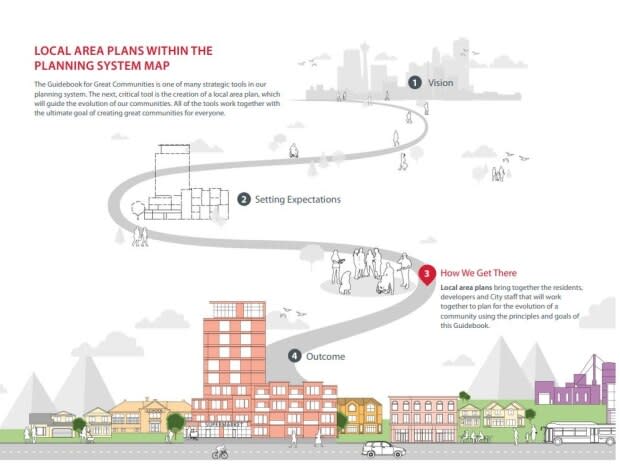Building up, building out: The balance Calgary planners want for established neighbourhoods
Planning how a city will grow and change is hard work — especially in already built-out communities.
And a new document, the Guidebook for Great Communities, looks at that conundrum in more than 140 pages, attempting to boil down a lexicon of city planning jargon for the everyday citizen.
Senior city planner Stephen Pearce said Calgary is looking to the future, especially because the size of Canadian households continues to shrink — the city can't keep building communities as they were conceived 50 to 60 years ago.
"Calgary will be growing both up and, and outward," Pearce said. "So, we're looking to balance that growth … creating communities that have more options for housing, more options for services for places to shop. That means, you know, kind of a little bit more intensity."

The directive in the guidebook's chapters is to build up already built-out communities. It means the Calgary of the future should have more density, more styles of housing, and more transportation choices to support the growing population.
But while it calls for more intensity or density, Pearce said it's still imperative the city feels walkable, and that buildings are constructed in a way that is still "human scale" — not imposing.
"It's not something that just happens tomorrow," Pearce said. "It's something that we work together to bring into the communities and those things kind of change incrementally over a matter of decades."
Pearce added the city is looking at the policy to enable choice that meets citizens' needs — whether that's affordability, choice or flexibility.

Leslie Evans, executive director at the Federation of Calgary Communities, said this means a complete overhaul of how planning is done and understood. For some communities, it's concerning.
While she said the plan to create more options and communities for everybody is great, some of the guidebook's principles are broad and lack focus.
"What we need is we need certainty for developers, we need certainty for city planners, and we need certainty for people who live, work and play in those communities," Evans said. "Right now, there's a lot of uncertainty because the language in the guidebook is very broad. It's an enabling language. It's not like it used to be."
"It's frustrating, the conversations have always been around, where are we putting density but nothing on the flipside." - Erin Joslin, Ramsay Community Association
Erin Joslin is with the Ramsay Community Association. She said some of those concerns centre around funding and directives about community investments that would give the document teeth and appeal for communities taking on density.
"It's frustrating. The conversations have always been around, where are we putting density, but nothing on the flipside," Joslin said. "Let's get some great bike connections from Ramsey to the rest of the city or pedestrian connections."
And while the document does talk about transportation choice, green spaces and more amenities, Evans with the federation said there is fear about where the funding for those upgrades will come from.
"How do we fund growth and change?" Evans said. "Funding is not just about park benches or rec centres, but it's about safety, transit, the streetscape … in our community's minds, it's missing some key things."
'Great communities for everyone'
The guidebook builds on the Municipal Development Plan (MDP), another city directive adopted in 2009. When council approved that plan, it was to create a vision for how the city develops over the next 30 to 60 years — an important plan for the future.
"We think about a city that can adapt to changes," Pearce said. "Some of the environmental changes, economic changes, and when we think about that households are changing generally."
He said this document is the menu, or building blocks, that will make up local area plans — yet another set of documents that will prescribe the community's vision for how an area will evolve. For example, where densification is appropriate, and how it is appropriate.
These local area plans will combine several communities into a single plan. Previously, the city had more than 200 planning documents about planning and development in Calgary and Pearce said this process will help simplify and update those area visions.
"[The guidebook] is a way of making it easier to start that conversation, because you've got a foundation to work from," Pearce said. "And then you can build on top of that."
Joslin with the Ramsay Community Association said as a volunteer, she can't keep up with the guidebook — a living document.
"The number of hours required to like, follow that document, while also being highly engaged in your Local Area Plan, has just been unprecedented," Joslin said. "Right now, I would just like to see, you know, a finished document, but I don't think we're ready to be at that point yet."
And she said that uncertainty makes it difficult to work on the Local Area Plan.
Some happy to see a shift in the city's planning process
Kourtney Branagan is the president of the Haysboro Community Association. The south Calgary community is currently using the guidebook to inform its Local Area Plan. And working closely with the document, she said she's come to understand and appreciate it.
"What I see is opportunity, I see choice," Branagan said. "We have an aging baby boomer population, who are occupying a lot of our established neighbourhoods, for them to make a move within their community doesn't exist … especially a lateral move."
She said everything innovates over time, including housing. And for her, the guidebook is innovating based on the expertise and best practices planners have gathered from what's working in other cities.
Know the impacts, get engaged, community leaders say
One of the big concerns right now, coming from the federation, is how the city is engaging citizens on this document — and whether Calgarians understand how important it is to be involved in the whole process.
"We've actually been engaging in trying to help people understand the guidebook," Evans said. "Citizens are an essential part of the planning process in Calgary, and while they may not understand the technicality of all the planning things … they're the ones that experience the community."
The federation has been holding events to engage community associations. And the city has also been engaging citizens with a display at the Central Library. Those engagement activities will continue until the end of February.
The Guidebook for Great Communities will be presented to a council committee on March 4 and go through an approval process.


